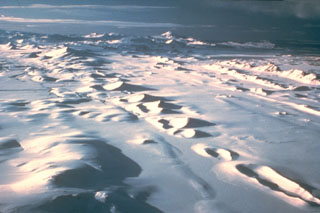Report on Bardarbunga (Iceland) — 8 January-14 January 2025
Smithsonian Institution / US Geological Survey
Weekly Volcanic Activity Report, 8 January-14 January 2025
Managing Editor: Sally Sennert.
Please cite this report as:
Global Volcanism Program, 2025. Report on Bardarbunga (Iceland) (Sennert, S, ed.). Weekly Volcanic Activity Report, 8 January-14 January 2025. Smithsonian Institution and US Geological Survey.
Bardarbunga
Iceland
64.633°N, 17.516°W; summit elev. 2000 m
All times are local (unless otherwise noted)
The Icelandic Meteorological Office (IMO) reported that an earthquake swarm began at Bárdarbunga at 0610 on 14 January in the NW part of the caldera. Initial estimates indicated that there were three earthquakes larger than an M 3 and one above an M 4; at 0705 the Aviation Color Code was raised to Yellow (the second lowest color on a four-color scale). The swarm continued though the morning and at 0805 a M 5 earthquake was detected. Seismicity began to decrease in intensity at around 0900 and continued at lower levels. The seismic network recorded about 130 earthquakes by 1418; seismicity continued overnight during 14-15 January. Similar activity occurred in 2014 before an effusive eruption that began after two weeks of unrest.
Geological Summary. The large central volcano of Bárðarbunga lies beneath the NW part of the Vatnajökull icecap, NW of Grímsvötn volcano, and contains a subglacial 700-m-deep caldera. Related fissure systems include the Veidivötn and Trollagigar fissures, which extend about 100 km SW to near Torfajökull volcano and 50 km NE to near Askja volcano, respectively. Voluminous fissure eruptions, including one at Thjorsarhraun, which produced the largest known Holocene lava flow on Earth with a volume of more than 21 km3, have occurred throughout the Holocene into historical time from the Veidivötn fissure system. The last major eruption of Veidivötn, in 1477, also produced a large tephra deposit. The subglacial Loki-Fögrufjöll volcanic system to the SW is also part of the Bárðarbunga volcanic system and contains two subglacial ridges extending from the largely subglacial Hamarinn central volcano; the Loki ridge trends to the NE and the Fögrufjöll ridge to the SW. Jökulhlaups (glacier-outburst floods) from eruptions at Bárðarbunga potentially affect drainages in all directions.

